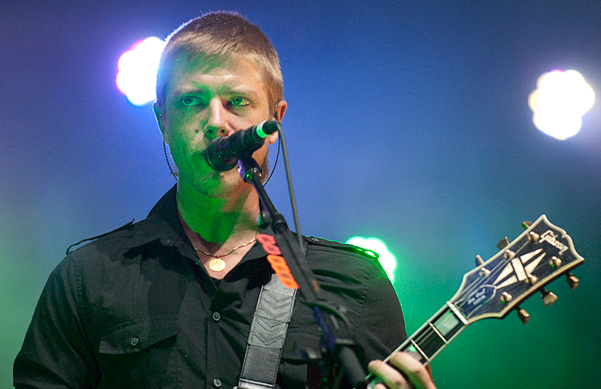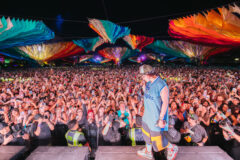The pinnacle of Interpol’s set on the first night of Coachella came after the New York City outfit walked offstage.
Two massive steel frames more than 50 feet high closed on the stage like sliding track doors, then ignited an epic light show that’s certainly one of, if not the, most ambitious spectacle in the fest’s 12-year-history. Columns of light blasted into the crowd and each triangular steel pipe was glowing and pulsing in rapid succession to dramatic, grinding sound effects – think the launch scene from the 1997 Jodie Foster film Contact. And the event was symbolic of the band’s set: Fresh, stylish, well-executed.
After the departure last year of Carlos “D” Dengler, the band’s founding bassist and most recognizable member, Interpol were in need of a rebirth. Singer-guitarist Paul Banks, drummer Sam Fogarino, and guitarist Daniel Kessler hired two new members — bassist David Pajo (YYYs) and keyboardist Brandon Curtis (Secret Machines) — and hit the road behind their latest album. But for Coachella the band had the opportunity to go big: They teamed with the Creators Project — the new initiative from Vice and Intel — to unveil the “new” Interpol, complete with an ambitious stage show.
It was a hits-filled 50-minute set that hinged on the combination of the visual and musical. Two huge LED screens showed four-split views of the band and their fans, as red numbers ran down the screen, like an IRS computer on the fritz. Four chest-high cubes sat onstage glowing behind the band and projecting the same.
One of the highlights came with the slow-dive of “NYC,” from the band’s career-making 2002 debut Turn On the Bright Lights. As Banks sang, “It’s up to me to turn on the bright lights,” in his cold robo-talk, fans were surrounded by just that: 10 spotlights shooting overhead, an art installation of glowing flowers 40 feet in the air, and the red lights around the periphery, illuminating the palm trees from the bottom up, like a fire had started.
During “The Heinrich Maneuver,” the LED screens turned to grids, then bullseyes, and focused on different members of the crowd, capturing their image and projecting it onto the cubes onstage.
The guys next door to me, stage right, loved it: “Sick,” they repeated with high fives, the drunker of the two tapping my shoulder over and over and singing into my mug. Then, “They should get a saxophone player.” Well, okay then!
While Interpol didn’t emerge from the set a “new” band — perhaps with that sax player — their show reminded a festival of tastemakers that, yes, they’re still alive and well, and as vital as ever.





